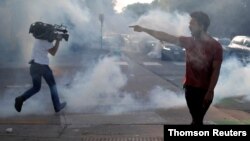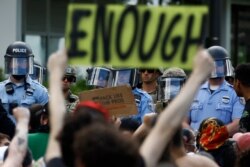Journalists covering protests against police brutality and racism across the U.S. found themselves part of the story over the weekend, with multiple reporters harassed, pepper-sprayed or injured.
Protests have long been a dangerous beat for the media, with a risk of harassment or injury from police and demonstrators alike.
The U.S. Press Freedom Tracker, which since 2017 has documented cases of journalists attacked or harassed, told VOA it is investigating more than 100 cases from last weekend.
That compares with 100 to 150 cases annually, said Kirstin McCudden, the site’s managing editor.
Among the first crews to make news was a CNN team arrested on Friday covering events in Minneapolis. Omar Jimenez and his colleagues were released a few hours later, and Minnesota Governor Tim Waltz issued what he called a “very public apology” for the arrest at a press conference later Friday. But as protests spread to other cities and violence erupted, more journalists and news outlets became targets.
CNN headquarters in Atlanta were vandalized; protesters harassed and chased away a Fox News crew reporting live outside the White House; at least two journalists were arrested in New York; and journalists in Detroit, Los Angeles, Washington, D.C., and elsewhere described being hit, shot at with rubber bullets or pepper-sprayed.
Michael Adams, a VICE news correspondent, shared video on Twitter of police pushing him to the ground at a Minneapolis gas station while another officer sprayed him directly in the face with pepper spray as he identified himself and held up credentials.
The incident filmed by the VICE news crew did not involve the Minneapolis Police Department, but the department is investigating incidents that did appear to involve its officers, John Elder, director of the office of public information for Minneapolis, told VOA. He added that several outside agencies have been assisting during the protests.
“In times like these, where there are numerous things happening at once, it is not always clear who is there to help and who is there to hurt,” Elder said via email. “We are looking at ways to better evaluate real time so that these mistakes do not occur.”
Julia Lerner, a University of Maryland journalism student, said a police officer pepper-sprayed her as she left a protest in Columbus, Ohio, on May 30. Lerner said she had been returning to her car after photographing protesters and identified herself as press.
“We have the First Amendment, we have the freedom of the press, we have the right to be here, to be standing on the sidelines, to be in the thick of it taking photos and recording and documenting these things happening,” Lerner told VOA. “And for police officers to be particularly targeting journalists who are just trying to tell the story as it's happening is anti-democratic.”
The student journalist said she didn’t think she was directly targeted for her work, but that police could have changed their approach once she identified herself. “I wasn't violent. I wasn't a threat. You know, I had my hands up. I'm literally not even 5 feet tall and I'm not a threat,” she said.
The Columbus city public information service did not immediately return VOA’s call requesting comment.
Bruce Brown, executive director of the Reporters Committee for the Free Press, described video footage of police assaulting journalists as “harrowing.”
“These attacks not only endanger our free press, but also threaten our democracy and the essential role that journalists play in safeguarding constitutional rights,” Brown said in a statement. “We also condemn all attacks on reporters by protesters. Media coverage of the demonstrations is indispensable to helping our nation bear witness.”
Early figures the Press Freedom Tacker shared on Twitter show at least 19 arrests, at least 36 cases of journalists hit by rubber bullets, and 76 assaults – 80% of which were by police – between May 28 and 31.
“It’s like nothing we’ve ever seen before,” McCudden said, adding that the Tracker is working to independently verify the cases. “What stood out was the targeting of journalists by protesters and law enforcement,” she said.
McCudden said that as a journalist she worries about the chilling effect the attacks may have on journalists, some of whom may be wary about continuing. “Think about what we’re losing when journalists stop their jobs,” she said.
The media’s role as watchdog was also raised by the American Civil Liberties Union (ACLU).
“People are in the streets demanding racial justice, and the public has a right to see it. The power of the people depends on the freedom of the press,” Brian Hauss, staff attorney with the ACLU’s Speech, Privacy, and Technology Project, told VOA
“The government cannot arrest reporters to prevent them from covering a demonstration, nor can it punish reporters because it disagrees with what they have to say,” Hauss added. “Everyone, including both protesters and journalists, has a First Amendment right to film and photograph police officers performing their duties in public.”
The National Association of Black Journalists (NABJ) said it is investigating reports of members being arrested, shot with rubber bullets, threatened or harassed.
“As black journalists, we are balancing the mistreatment of being a member of the press with also the pain of being black in America,” Dorothy Tucker, president of the association, said in a statement shared with VOA.
Wesley Lowery was arrested in 2014 while covering protests for The Washington Post in Ferguson, Missouri, after the fatal shooting of Michael Brown. “African American reporters face a unique set of circumstances that many of our colleagues do not,” said Lowery, who is black.
Speaking after the arrest Friday of the CNN crew, Lowery said protesters, law enforcement and others may perceive African American journalists as “bad actors,” or “more loyal to the cause than we are to the truth.” Jimenez identifies as black and Latino, CNN reported.
Lowery said there is a level of stress a black journalist has to deal with in covering "a bunch of people who look like you, despairing because the government has killed someone who looks like you. It could be you. It could be your father; it could be your son.”
Still, he said, “Black journalists have always been able to still show up and tell the truth and do their jobs.”
This story has been updated with comment from the Minneapolis Police Department.









